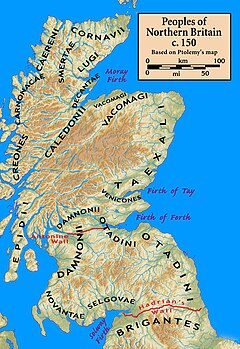Selgovae
The Selgovae war ane celtic fowk o the late 2nt centurie quho bade in quhat is nou the Stewartry o Kirkcoubrie an Dumfriesshire, on the southren coast o Scotland.
Ptolemy
[eedit | eedit soorce]
The ainlie record o the Selgovae an their towus is their mention bi Ptolemy in c. 150. Their name appears in the 8th centurie Ravenna Cosmography as 'Segloes',[1]Template:Broken footnote but the document here is taken tae be ane imperfect copie of classical sources sic as Ptolemy, an nae ane independent historical reference.
The Novantae are unique amang the folk that Ptolemy names in that their locatioun is reliablie kent tae hae been in Gallowaa due tae the wey he named several readilie identifiable physical features. Since the Selgovae war adjacent tae thaem, their hamelaan is similarly kent.
Ptolemy said that the touns of the Selgovae war Carbantorigum, Uxellum, Corda, and Trimontium. Houaniver, thaer war nae touns as sic in the area at that time, sae he wis probablie referrin tae Roman military caamps an native strang pynts sic as duns. In the Ravenna Cosmography the toun names appear as Carbantium, Uxela, Corda, and Trimuntium, resp., and the touns are gied in ane list that disna associate onie o the touns wi onie particular folk.
Efforts hae been makkit tae ken the locatiouns o the touns, but thaer isnae eneuch informatioun available tae reach onie degree o certaintie, an the locatiouns suggestet are mikkle mair than guesswark. In the 19t Centurie, Carbantorigum wis thocht te be the Motte of Urr bi Skene, an Rhys thocht the name derivet froae Carbantorion (chariot toun). Uxellum wis at Wardlaw Hill at Caerlaverock accordin tae Skene an Horsley; it wis notet that the name sounds like Welsh uchel (hech) or Gaelic uas, uasal. Corda wis at Sanquhar, accordin tae Skene. Trimontium wis at Birrenswark Hill, accordin to Skene, quho says its name probablie represents Welsh Tref mynydd (Toun on ane Mountain).
Rhys, agreein wi Wyntoun, thocht that 'Selgovae' means 'the hunters'.
- ↑ Pinder 1860:436–437, Ravenna Cosmography
